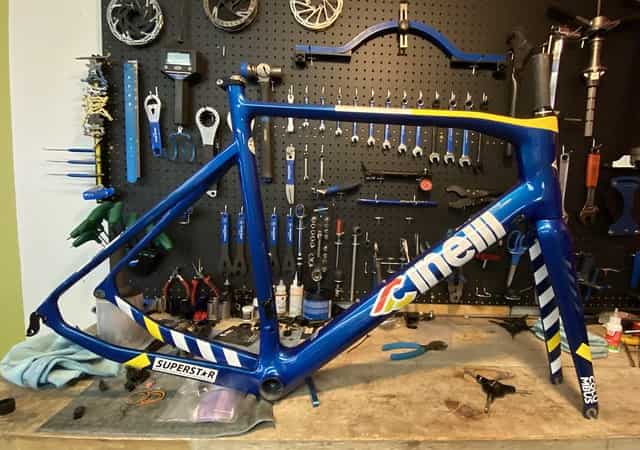Most bike frames are made out of aluminum, which is a strong and durable material in and of itself. However, the alternative is a carbon bike frame.
These frames can be even more resistant than the aluminum option because the layering of carbon fibers makes the material laterally stiff and great at dampening the vibrations generated during a ride.
On a carbon bike you’ll feel more comfortable and incredibly stable.
An aluminum frame should last for a solid 6 years, as should a steel frame, so a carbon frame can confidently outlast either of those by a year at minimum.
Of course, a steel frame will require regular maintenance to keep in good condition (as any bicycle frame does), but the material itself is deliberately made to stand up to damage.
Well-maintained bike frames can easily last up to 10 years, though you’ll want to keep checking that your frame is still secure and safe for you to use.
What It Means To Have A Carbon Bike
Having a carbon bike will allow you to cycle more confidently on harder routes because the durability of the frame will stand up to the usual wear and tear that you’d expect from rougher terrain.
The frame will resist a lot of potential damage from debris, unkempt branches and other plants, and bad weather, so you’ll be able to challenge yourself on a carbon bike and cycle it off-road, so long as you also have off-road tires.
You will also achieve maximum comfort while riding a carbon bike because the material is designed to absorb road vibration, allowing you to stay stably in place for the entire journey.
This makes longer rides much more accessible, though you should still make sure your bike has padded saddle.
The lightness of a carbon fiber frame is also a huge bonus because you will not be pairing a heavy frame with heavy wheels. By reducing the weight before you get onto the bike, you are guaranteeing a smoother ride.
How Long Do Carbon Bike Frames Last?
As previously stated, the design of a carbon frame means that it does not necessarily have a shelf life because of the maximized durability of the material.
However, most manufacturers would recommend that you replace your carbon frame every 7 years just to make sure that it is still in the best riding condition.
This is not a set “expiration” date though because these frames are super resistant and have the potential to last well beyond 7 years.
But if you are cycling regularly, you may benefit from a new frame after that time to keep your bike in the best condition possible. Weather conditions, uneven terrain and unkempt routes, and just the passage of time will all take their toll on a bike frame, even one as robust as the carbon frame.
You don’t want to risk cycling with an unsteady or unpredictable bike just because the carbon frame has the potential to last well beyond 7 years, so keep checking the condition to ensure it doesn’t need to be changed.
Factors That Affect Life of Carbon Bike Frames
Quality of Resin
The resin used on a carbon frame is made up of carbon composite and epoxy. Its quality is vastly superior to other resins available on the market because it has been shown to last for a long time.
A high-quality resin will extend the life of your bike’s frame by making it more durable and protecting it. You will not see any degradation of the composite over the lifetime of the bike.
A low-quality resin will show little resistance to the effects of general fatigue as the bike ages, so the resin used on a carbon frame is essential to improving its overall state.
A good resin will also make the frame look good because it’ll be perfectly assembled. By keeping an eye on your bike’s resin, you will ensure it outlasts its predicted lifespan.
Build Quality
As the name suggests, the build quality of a bike is very important. Bike retailers all try to build bikes of the best quality, but those with better builds are much more likely to last.
And though material is important, it is of little matter if the build quality of a bike is not good.
As previously established, the layering of carbon fibers makes the material of a carbon frame extremely robust, but a poorly built bike will easily fall to pieces regardless.
In the recommended 7 years, you’ll get plenty of use out of your carbon bike, but a pristine built frame will extend its shelf life. ( About 10 years on average )
The carbon fibers layered to form the frame parts are stiff yet malleable, so they can be shaped to the best standard and then attached together with the resin.
You will get the best build quality from all reputable manufacturer that sell carbon bike frames.
Quality of Carbon Fiber
To follow on from that previous point, pairing a high-quality resin with a high-quality carbon fiber is the best way to get a long-lasting carbon bike.
The better the quality of the fibers, the stronger the frame will be, especially if it is well built and held together by a good resin.
You will have to pay more for high quality carbon fibers because carbon is a more expensive bike material, but it will be worth it for the increased tolerance of the frame.
The bike will be stronger, more aerodynamic and fantastic to look at. A well put together frame made up of several layers of carbon fiber should feel quite light too. High quality materials will only add to your biking experience.
Impact Resistance
One final factor that affects the life of your carbon frame is its impact resistance. A frame with higher impact resistance will come away from a crash or hit with less damage than one with a lower impact resistance.
Of course, any serious impact can cause damage to your bike, but the resistance is essential for minimizing that damage as much as possible.
The strength of carbon fiber has been reiterated before, but it really is one of the best things about these bikes.
Aluminum is very durable too, but you can be more assured that a carbon bike will resist the same level impact more than an aluminum frame.
The extra weight of a carbon frame helps because, though slightly bulkier, this gives them more layers of protection. You are also less likely to hit a big impact at high speed on a carbon bike because you will be more streamlined and less weighed down on an aluminum road bike, for example.
How Carbon Bike Frames May Get Damaged
A Sudden Impact
One of the easiest ways to damage a bike is through impact. Though bikes are designed to be aerodynamic and balanced, you can still end up crashing the bike or it toppling over if you are riding on uneven surfaces or during adverse weather.
And though a carbon frame is built to resist and last, hard impact will still damage it. The only way that you can really prevent an impact risk is to pay attention to when and how you cycle.
For example, choose to cycle more complicated off-road routes in clear conditions because heavy rain or strong winds are more likely to cause you to lose control.
If you have to cycle in difficult weather then try to stick to smoother, flatter routes and don’t go off-road.
As for the ‘how’, know your abilities. Make sure that you are well practiced and prepared for harder trails and don’t carry on cycling if you feel tired or overwhelmed.
This will reduce the risk of you crashing, which subsequently reduces the risk of impact on the bike.
Excessive Pressure or Load
Another thing that is within your control is how much weight you put on the bike. Carbon frames are shaped to make the bike sturdy and comfortable, so you should be able to easily find one to support your height and weight.
Beyond that, try not to over pack your bike because an excessive load will cause the frame to sag a little and put lots of pressure on the wheels to keep moving.
If you put too much strain on a bike, whether carbon or aluminum, then it will impede the performance.
And extreme weight on top of the frame’s current weight will have them moving very slowly and cause you to exert yourself more to make the pedals work.
Packing just the essentials and spreading them around the bike (front basket and rear rack) will even out the weight and allow a smoother ride that won’t pressurize the bike.
Prolonged Sun Exposure (UV- Light)
Most people keep their bikes in a shed or garage when they are not being used, which is the best way to prevent damage caused by prolonged sun exposure.
As previously stated, the quality of the resin is important to the lifespan of the bicycle, so you need to protect it.
Luckily, carbon frames are usually painted with UV-resistant lacquers as an external layer of protection.
But that doesn’t mean you should expose your carbon bike to unnecessary UV. If you are cycling on a very sunny day, ensure that you place your bike in the shade whenever you stop to take a rest.
And you should afford you bike a covered space to protect it from UV exposure.
If you cannot put it inside a shed or garage, get a large sheet to cover your bike with, or leave it somewhere safe that you know will always be shaded, such as under a large tree.
Improper Care
Any cyclist will know that you need to care for your bicycle in order for it to remain in the best condition possible, and this is true for carbon bike frames as well.
If you do not regularly clean your bike and inspect the frame for damage, you are causing unnecessary harm to it and potentially missing damage that could lead to injury.
A clean frame is best for the bike and will prevent the paintwork on the frame from being tarnished.
Caring for a bike also includes taking it to a professional to have parts fixed or swapped out when they become damaged. You wouldn’t cycle on damaged tires, so why would you cycle with a damaged frame?
The carbon fibers that make up the material will last, but proper care and attention is the easiest way to maintain the frame and prevent you from having to spend money on repairs.

How To Maintain A Carbon Bike
All of the aforementioned potentially damaging situations can cause unnecessary pressure to your bike, so organizing a proper care routine is the best way to maintain a carbon bike.
You should have plenty of faith in its durability, but don’t put it through more strain than required during a ride.
The most important maintenance tips have already been covered: reducing risks, preventing overloading, ensuring cover, and completing a regular care routine. But there is more that you can do as well.
When you wash the frame, use warm soapy water or a hosepipe to gently clean off any dirt.
Don’t scrub the carbon frame. And if you notice your rag snagging on something while you clean, it’s a sign of damage, so you can inspect the frame more closely.
And while working on your bike to maintain it is one of the best things you can do, you should also take precautions.
Having a workbench is the best way to work on your carbon bike because using a clamp risks over-tightening and crushing the carbon tubes.
You should always avoid over-tightening other bike components as well, such as the handlebars, because they can be crushed too. Installing a chain catcher will benefit you as well, just in case the chain drops from the front derailleur. Then, finish off the maintenance job with a polish designed specifically for carbon bikes.
Are Carbon Bike Frames Worth It?
You may be questioning whether it is actually worth it to purchase a carbon bike because the frames require a lot of maintenance and attention, but any responsible bike owner will want to spend time looking after their bicycle.
And aluminum and steel bikes will also require lots of maintenance, especially if you are a frequent rider, so a carbon frame won’t necessarily bring you more work.
As for price, carbon bikes are the more expensive option because manufacturing carbon is simply more costly than aluminum. Carbon frames also require specific molds, so the process is longer.
However, with a longer lifespan and improved features, carbon bikes are definitely worth it.
If you are looking to cycle on-road only then you may prefer a more lightweight bike, but the carbon option is great for mountain biking, countryside routes and any rougher terrain.
The main thing to take into account when deciding if a carbon bike is right for you is your ability. If you are a beginner cyclist looking to casually ride easy routes then you likely won’t get your money’s worth.
But serious cyclist who wants to tackle new, more adventurous routes will absolutely benefit from a carbon bike.
Bottom Line
Ultimately, the easiest way to ensure that your bike outlives its predicted shelf lifespan is to take great care of it. After all, a bike is an investment, so you’ll need a solid organized plan for how you’ll maintain your carbon bike.
You should ride it as much as you like and utilize its features and resistance to tackle harder routes, so long as you clean and check it for damage afterwards.
Also Read,
Can You Put Drop Handlebars On A Hybrid Bike?
Can I Ride A Mountain Bike on Streets, Roads & Pavements?









Leave a Reply